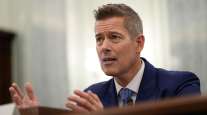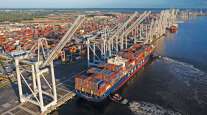Infrastructure Boost Fades in US Economic-Growth Forecasts

President Donald Trump is stepping up the fanfare around his $1 trillion infrastructure proposal, but the plan is fast becoming a nonfactor in forecasts for U.S. economic growth.
The administration is in the midst of an “infrastructure week” of big ideas spanning air traffic, waterways and roads, attempting to move forward on campaign promises to create millions of jobs and spur growth to rates not seen in recent years. The reality is, many concrete details are still missing on specific policies and programs, timelines, costs and the savings or employment they’ll generate.
On top of that, other signature Trump initiatives including health care and tax reform are making little progress in Congress, plus distractions such as probes involving Russia are taking a toll. That’s all making it increasingly difficult for economists to expect any boost from infrastructure for at least a couple of years.
“The big-bang infrastructure plan that people were maybe holding on to the night he won the election, this massive package that was going to rebuild roads and bridges and highways and put all these people to work, a lot of that is out the door,” said Neil Dutta, head of U.S. economics at Renaissance Macro Research. “I don’t think something like that is in the cards, definitely not this year and maybe not even ever. Part of that is because this is the year of investigations, not legislation.”
While there’s broad agreement on the need to improve aging infrastructure including railroads, highways and airports, an economic boost seems like a weak justification at a time when the labor market is close to full employment and output is growing around its long-term potential.
Morgan Stanley economists, coming to terms with the delays, removed the infrastructure plan from their economic calculations the week ended June 10, citing “little clarity from the administration.” They also pushed out the implementation of tax reform to the first half of 2018 from the second half of 2017.
Global Rebound
Instead of a downgrade, though, they project even stronger growth this year: 2.2% rather than 1.9% they previously forecast. In a note on June 4, analysts led by Chief U.S. Economist Ellen Zentner attributed the outlook to supportive financial conditions, a global economic rebound and pickup in investment thanks to looser regulations. They kept the 2018 estimate at 1.9%.
Economists at Deutsche Bank, who also threw in the towel on near-term fiscal policy progress, still project the economy will expand 2.6% this year and 2.4% next year.
Deutsche Bank expected the administration would be “achieving significant elements of tax reform, infrastructure spending and deregulation as soon as this year, [but that] now seems much less likely,” Chief Economist Peter Hooper wrote May 10.
“We already expected only a very small fiscal stimulus at the end of the year,” said Ethan Harris, head of global economics research at Bank of America Merrill Lynch. “That’s been our forecast since the election. But now we’re talking about the rising probability that there’s no stimulus at all.”
Trump’s 2018 budget plan assumes implementation of his policies and sees growth picking up as a result, from 2.3% this year to 2.5% in 2018 and 3% in the long term. The administration proposed $200 billion over a decade for infrastructure outlays, hoping to leverage it “such that the end result is at least $1 trillion in total infrastructure spending” involving states, cities and private investors.
“I’m calling on all Democrats and Republicans to join together, if that’s possible, in the great rebuilding of America,” Trump said June 7 in a speech in Cincinnati, citing the “dire and even desperate condition” of infrastructure across the nation.
While infrastructure investment and “rational immigration policy” can accelerate growth, the chances of getting those done are “well under 50-50, because we’re spending our time on budgets that don’t add up, and on scandals and tweets,” Larry Summers, a Harvard University professor and former chief economic adviser to President Barack Obama, said June 5 on Bloomberg Television.
Trump earlier this week announced a plan to transfer the air-traffic control system to a nonprofit corporation. He aims to improve efficiency, cut delays in clearing projects and increase private-sector participation. Yet infrastructure projects are cumbersome to design, finance and implement, while the benefits follow with a lag.
Working out the nitty-gritty of delivering policy changes quickly is now “a job for Congress,” said Michael Likosky, head of infrastructure at 32 Advisors, a New York firm that advises on investments. While it’s “likely to take some time,” Likosky said he’s hopeful that later this year “we’re going to see projects ready to go pretty quickly.”
Public-Private
There’s a bigger opportunity for public-private partnerships, Likosky said, adding that the Obama administration “experimented with it but they never brought it to scale.”
Critics argue that Obama’s 2009 stimulus, which included transportation investment, provided a temporary economic boost that faded in a few years while it was expected to increase debt down the road. The additional demand for infrastructure-related labor could also run up against a shortage of workers and impede other sectors such as home construction.
Those would become risks once shovel-ready projects actually begin. Meanwhile, consumer and business spending are rising and the drag from trade is diminishing, Dutta said. Rather than count on Trump’s plans, the economy can look to a “more-balanced backdrop for growth.”




